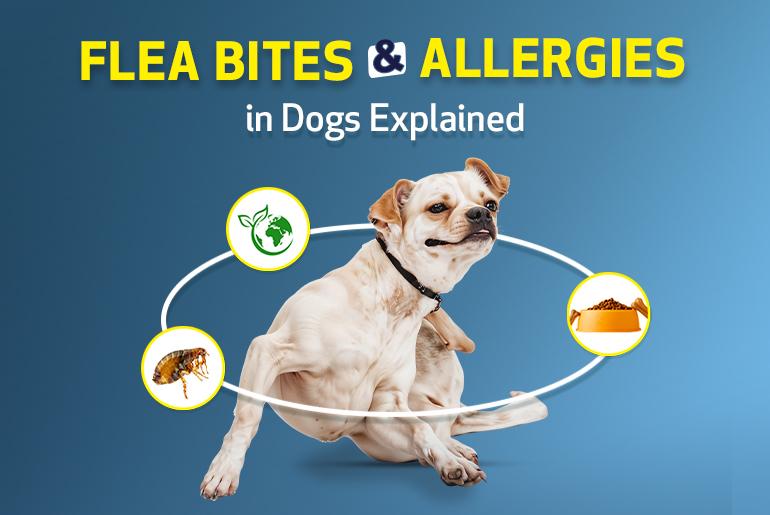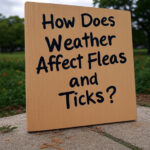When you sit to reason your pet’s itching, more often you find parasites such as fleas to be the culprit, but it’s not always the case. There are other allergies that may be responsible for why your dog is going to town on scratching and licking or experiencing digestive or respiratory issues.
As a responsible dog parent, it’s imperative you understand the differences and ways to recognize the discomfort your pet is going through. In this blog, you’ll discover the different types of allergies that can affect your furry friend, their causes, and the common symptoms. We’ll also cover some effective ways to prevent and manage these allergies so your pet can lead a happier, itch-free life.
Let’s jump right into it!
Various Allergies in Dogs
In this segment, we’ll explore the different allergies your dog is vulnerable to and their causes.
Flea Bites and Flea Allergy Dermatitis
When fleas bite the dog for a blood meal, they secrete saliva into the bloodstream, which is an allergen for them. This triggers an allergic reaction known as flea allergy dermatitis or flea bite hypersensitivity. It makes the dog itchy all over, and in an attempt to relieve themselves, they bite, lick, and/or scratch themselves. This often leads to secondary skin infections, such as hair loss, reddened skin, crusts, and scaling.
Dogs with flea allergy dermatitis (FAD) are sensitive to flea bites, and only a few bites can lead to this condition. Therefore, even if you don’t see live fleas, there’s a possibility they might still have FAD. However, flea infestation is another story in itself, a severe one, if not addressed in a timely manner.
The major difference between them is that a flea bite causes localized itching and redness at the bite location, whereas, flea allergy dermatitis is an allergic reaction to flea saliva, causing intense itching, redness, and skin inflammation beyond the biting site.
Common symptoms of fleas or flea allergy dermatitis are:
- Visible fleas or flea dirt
- Excessive itching, scratching, biting, and licking
- Red spots or patches
- Small bumps around the body or the neck
- Hair loss
- Inflammation
- Reduced appetite
Mentioned below are other factors that can cause skin allergies in dogs:
Food Allergies
Food allergies in dogs are an adverse reaction of the immune system to a specific ingredient or additive in food. Typically, it’s the protein or complex carbohydrates that the dog’s immune system recognizes as an allergen and overreacts to attack it. This response often causes reactions like skin or gastrointestinal issues. The most common food allergens are chicken, beef, pork, corn, soy, and wheat.
It is believed that food allergies are genetic in nature, but they can also develop at any stage of your dog’s life. Therefore, it is challenging to single out specific ingredients responsible for allergies. The most effective method used by vets is the elimination diet, in which the dog is fed a hypoallergenic diet. Then, the old diet is reintroduced with one food item at a time to identify the intolerant substances.
Environmental Allergies
Environmental allergies or seasonal allergies, are caused by the allergens in your home, backyard, and everywhere your dog stays. The most common allergens include pollens, certain plants, animal fibers, dust mites, and mold spores. The primary symptoms include, excessive itching, licking, or scratching, hair loss, ear infection, sneezing, head shaking, red skin, or gastrointestinal issues.
Measures to Prevent Allergies in Dogs
Here are some valuable tips you can use to protect your dog against allergies:
- Minimize their exposure to potential allergens.
- Maintain cleanliness inside the house, especially the places most used by your dog.
- Administer flea and tick treatments for dogs recommended by your vet.
- Maintain regular vet visits.
- Create a grooming regime and stick to it.
- Plan a diet devoid of harmful ingredients.
- When going out for walks, avoid heavily wooded areas.
- Take care of their skin & coat health and use hypoallergenic shampoos.
Along with these preventive measures, you can look into the following treatments to ensure your pet’s protection against parasites and allergies.
Simparica Trio
Simparica Trio for dogs is a broad-spectrum oral treatment formulated to protect dogs and puppies from 8 weeks of age, weighing at least 2.8 lbs., against a wide range of parasites. This monthly treatment kills fleas, treats and controls 6 types of ticks, and treats and controls roundworms & hookworms. Plus, it aids in the prevention of heartworm disease and Lyme disease.
Apoquel
Apoquel is specially designed to control pruritus associated with atopic and allergic dermatitis in dogs. This easy-to-administer oral treatment inhibits the activities of itch-causing enzymes and provides prompt relief from itching.
Bravecto Chews
Bravecto is a long-lasting oral flea and tick treatment designed to protect dogs and puppies from 8 weeks 6 months of age and weighing at least 4.4 lbs. With Fluralaner as the active ingredient, these flavored chews protect against fleas and multiple tick species and also help relieve the symptoms of flea allergy dermatitis.
Parting Words
Whether it’s fleas, food sensitivities, or environmental allergens, understanding the root cause is the first step toward finding relief from itching and discomfort. In this informative blog, we’ve covered the fundamentals of flea bites and other allergies to help you identify the issue. So, put this information to good use and practice the preventive measures mentioned to help your canine companion lead a happy and itch-free life!




